Perspective on CPI Data by Ms. Rajani Sinha, Chief Economist, CareEdge

Follow us Now on Telegram ! Get daily 10 - 12 important updates on Business, Finance and Investment. Join our Telegram Channel
Below the Perspective on CPI Data by Ms. Rajani Sinha, Chief Economist, CareEdge
“In line with our expectations, the CPI inflation inched up further to a 14-month high of 6.2% in October. Core inflation also saw a minor uptick of 20 bps to 3.7% in October. Despite a favourable base and benign core inflation, high food inflation has kept the headline inflation elevated. High food inflation led by strong momentum in prices of vegetable and edible oil remains a cause of concern. The surge in vegetable prices, particularly tomatoes and onions, can be attributed to unseasonal rains and extended monsoons in certain parts of the country. The rise in global edible oil prices and the recent hike in the basic customs duty of various edible oils have resulted in higher inflation in the basket, given their import dependence. It is crucial to manage food inflation, as it directly impacts household inflation expectations. This situation also underscores the need for the government to implement additional supply-side measures to stabilize food prices.
Looking ahead, the arrival of the fresh harvest is expected to ease inflationary pressures on food prices. The outlook for rabi sowing is promising, with reservoir levels across most regions remaining higher than last year, except in certain northern states such as Punjab and Himachal Pradesh. Additionally, the higher soil moisture levels resulting from the delayed monsoon withdrawal will also support rabi sowing.
Subdued global commodity prices amid concerns over global demand should further aid in moderation of the headline inflation going ahead. In October, global commodity price index declined by 4.3% YoY, while Brent crude prices fell by 15% YoY. However, it is crucial to monitor geopolitical developments closely, as these could significantly influence global commodity markets and supply chains.
Current trends suggest that inflation in the second half of FY25 may exceed the RBI's October projections, potentially delaying the start of a rate-cutting cycle. With headline inflation above the upper end of the RBI's tolerance band, the MPC will remain cautious and is likely to maintain status quo on policy rates in the December meeting. We anticipate that headline inflation will fall below 5% by Q4 FY25, driven by a moderation in food inflation. This would create an opportunity for the MPC to consider a 25-bps reduction in policy rates in February meeting. For the full year FY25, we expect CPI inflation to average 4.8%.”
Above views are of the author and not of the website kindly read disclaimer










More News

Quote on Monetary Policy Committee Announcement from Dr. Poonam Tandon, Chief Investment Off...












